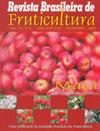不同成熟期5个生态型紫花Spondias purpurea L.采后品质及生理变化
IF 0.9
4区 农林科学
Q4 HORTICULTURE
引用次数: 0
摘要
摘要:在拉丁美洲不同地区,棘球蚴的果实被广泛接受。然而,在许多情况下,它们的采后品质和生理行为尚未得到充分的研究。因此,对来自墨西哥的五个商业种植生态型进行了这些方面的研究。为此,将未成熟、半成熟和成熟的水果样品在25°C (60% RH)下储存5天,并定期评估若干质量指标和采后行为。5个生态型中有4个产生了大核果(>“Costeña”、“Amarilla”、“Morada”和“Costilluda”中的15克)。另一方面,在重量损失(5 - 21%)和成熟果实的总可溶性固形物(9 - 17%)方面的巨大差异是明显的,当它们在树上从绿色过渡到半成熟阶段时,核果重量增加了9.3%,这表明采收应该在这一时期进行。二氧化碳和乙烯产量的增加都与采后寿命的缩短有关。严格根据硬度,最有可能抵抗采后处理的生态型是“莫拉达”和“保守”。另一方面,“Amarilla”和“Costeña”获得了全球最佳品质奖。本文章由计算机程序翻译,如有差异,请以英文原文为准。
Postharvest quality and physiological changes in five ecotypes of Spondias purpurea L. harvested at three distinct maturity stages
Abstract The fruit of Spondias purpurea L. is well accepted from different regions of Latin America. In many cases, however, their postharvest quality and physiological behavior have not been adequately studied. These aspects were therefore examined in five commercially grown ecotypes from Mexico. To this end, samples of green-, half ripe-, and ripe-harvested fruit were stored at 25 °C (60 % RH) for 5 d – with several indicators of quality and postharvest behavior periodically assessed. Four out of the five ecotypes examined produced drupes that were large (> 15 g in ‘Costeña’, ‘Amarilla’, ‘Morada’, and ‘Costilluda’). On the other hand, large differences in weight loss (5–21 %) and in the total soluble solids of ripe fruit (9–17 %) were apparent, as was a 9.3 % increase in the weight of drupes when they transitioned from the green to the half ripe stage on trees, suggesting that harvesting should take place during this period. Increments in the production of CO2 and ethylene were both associated with a shortening of postharvest life. Based strictly on firmness, the ecotypes most likely to resist postharvest handling were ‘Morada’ and ‘Conservera’. Best global quality on the other hand, belonged to ‘Amarilla’ and ‘Costeña’
求助全文
通过发布文献求助,成功后即可免费获取论文全文。
去求助
来源期刊
CiteScore
1.50
自引率
20.00%
发文量
34
审稿时长
4-8 weeks
期刊介绍:
The Revista Brasileira de Fruticultura (RBF) publishes technical articles and scientific communications in the area of fruit crops, referring to results of original searches and unpublished papers in Portuguese, Spanish or English, and 1 or 2 reviews per edition, of invited authors.

 求助内容:
求助内容: 应助结果提醒方式:
应助结果提醒方式:


